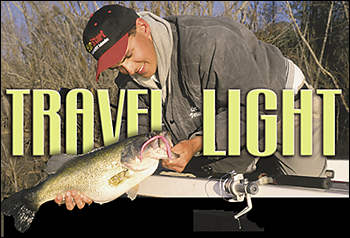
Downsizing your bass arsenal
will give you more bang for your buck.
By Matt Williams
East Texas bass fishing guide Carl Vessel owns his fair share of heavy artillery. But come May - the dreaded spring/summer transitional month when bass often become finicky and tough to catch - he has learned he can sometimes get more bang for his buck by swapping his rhino-backed flippin' sticks and crankin' rods for a microlight fishing system some may deem better-suited for a high country trout lake chock full of 12-inchers.
He calls it traveling light.
"Bass can at times be very difficult to catch this time of year, especially on reservoirs where they have been getting an abundance of pressure over the last few months," he explains. "Most of them will have seen just about every lure in the book and many will be reluctant to strike a conventional bait like a spinnerbait or jig.
"The idea behind switching to light tackle," he continues, "is you're opening the door to a world of baits and fishing techniques the bass are not going to be accustomed to seeing. It gives you the ability to achieve incredibly live-action with certain types of lures and to present them in a manner the fish find hard to resist. Bottom line is, it's something different."
Don't be misled, here. Traveling light is nothing new to the bass fishing spectrum.

While soft plastics in a variety of styles and colors are generally the bait of choice when traveling light, small crankbaits, spinnerbaits and topwaters will also effectively finesse fish from cover.
|
Veteran pro anglers like Guido Hibdon and Shaw Grigsby have been utilizing spinning gear and finesse baits to help pad their pocketbooks for years. Noted predominantly for their light tackle wizardry with spawning lunkers, Hibdon and Grigsby will be quick to tell you that light tackle "finesse fishing" can be equally effective at other times well.
And so will Tommy Martin. Martin, an 18-time BassMasters Classic qualifier and veteran Toledo Bend guide, says there are several factors that tell him to think about making the switch. Among these elements are the size of bass known to inhabit a given reservoir, water clarity, available cover and, more importantly, the amount of fishing pressure placed on existing bass populations.
"Finesse fishing will work just about anywhere, anytime," explains Martin. "But it has been my experience that it shines the brightest on reservoirs that don't have a lot of big fish in them. There is just not a whole lot of sense fishing a giant bait when you're looking for a limit of 1- to 3-pounders that'll weigh between 14 and 15 pounds.
"It also can be very effective when a lake has been under a tremendous amount of pressure or when you're fishing an impoundment with extremely clear water and very little available cover," adds Martin. "Oftentimes, bass are reluctant to hit a big, noisy bait in these types of situations, whereas they'll eat a small or more subtle one up."
Both Martin and Vessel will incorporate a wide range of lures into their light tackle bassin' schemes. Soft plastics such as the Zoom Trick Worm, Finesse Worm, Salty Centipede, Fluke and even the Baby Brush Hog will produce banner results when fished in combination with 8- or 10-pound-test line and open-face spinning gear. Here are some innovative ways you can make them work for you:
Floating Worm
According to Martin, the terminology here is somewhat deceptive in that the floating worm rig doesn't actually float. Instead, it runs just below the surface, darting back and forth in an erratic fashion.
Building a floating worm rig is relatively simple. Cut a 1-foot leader off the main line and tie it to one end of a No. 7 barrel swivel. The swivel will act as a light sinker to get the bait down, plus cut down on line twist.
Attach the opposite end of the swivel to the main line, then tie a 3/0 straight shank hook to the free end of the leader. Rig the worm on the hook as if you were fishing Texas-style.
Using a staggered, twitching retrieve, Martin fishes the floating worm over submerged grass and around scattered shoreline vegetation such as hydrilla, duck weed, stick-ups, bushes and laydowns. "This a real good bait choice when the fish are active, but somewhat reluctant to hit other baits," says Martin. "Fished correctly, it'll 'walk the dog' just beneath the surface. The bass can't stand it."
Martin prefers bright colors in a floating worm, because he likes to keep eye contact with his bait at all times. White, methylate, bubblegum and pink are among his favorite colors.
continued
page 1 / page 2
| 




